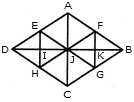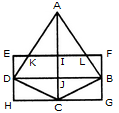Discussion
Home ‣ Non Verbal Reasoning ‣ Analytical Reasoning See What Others Are Saying!
- Question
Find the number of triangles in the given figure.

Options- A. 16
- B. 22
- C. 28
- D. 32
- Correct Answer
- 28
ExplanationThe figure may be labelled as shown.
The simplest triangles are AFJ, FJK, FKB, BKG, JKG, JGC, HJC, HIJ, DIH, DEI, EIJ and AEJ i.e. 12 in number.
The triangles composed of two components each are JFB, FBG, BJG, JFG, DEJ, EJH, DJH and DEH i.e. 8 in number.
The triangles composed of three components each are AJB, JBC, DJC and ADJ i.e. 4 in number.
The triangles composed of six components each are DAB, ABC, BCD and ADC i.e. 4 in number.
Thus, there are 12 + 8 + 4 + 4 = 28 triangles in the figure.
More questions
- 1. Choose the alternative which is closely resembles the water-image of the given combination.

Options- A. 1
- B. 2
- C. 3
- D. 4 Discuss
Correct Answer: 2
- 2. Identify the two figures from the given figures which are identical:
Options- A. 1 - 3
- B. 4 - 6
- C. 2 - 4
- D. 3 - 5 Discuss
Correct Answer: 2 - 4
Explanation:
Figures 2 and 4 are identical.
- 3. Which answer figure will complete the pattern in the question figure?
Options- A. 1
- B. 2
- C. 3
- D. 4 Discuss
Correct Answer: 3
Explanation:
NA
- 4. Select a suitable figure from the Answer Figures that would replace the question mark (?).
Problem Figures: Answer Figures:
 (A) (B) (C) (D) (1) (2) (3) (4) (5)
(A) (B) (C) (D) (1) (2) (3) (4) (5)
Options- A. 1
- B. 2
- C. 3
- D. 4
- E. 5 Discuss
Correct Answer: 4
Explanation:
The elements move downwards along the diagonal and the lowermost element moves to the uppermost position. The triangle and the half shaded rectangle get vertically inverted and the pentagon rotates 90 oCW.- 5. Find the number of triangles in the given figure.

Options- A. 11
- B. 13
- C. 15
- D. 17 Discuss
Correct Answer: 15
Explanation:
The figure may be labelled as shown.
The simplest triangles are AKI, AIL, EKD, LFB, DJC, BJC, DHC and BCG i.e. 8 in number.
The triangles composed of two components each are AKL, ADJ, AJB and DBC i.e. 4 in number.
The triangles composed of the three components each are ADC and ABC i.e. 2 in number.
There is only one triangle i.e. ADB composed of four components.
Thus, there are 8+ 4 + 2 + 1= 15 triangles in the figure.
- 6. Select a suitable figure from the Answer Figures that would replace the question mark (?).
Problem Figures: Answer Figures:
 (A) (B) (C) (D) (1) (2) (3) (4) (5)
(A) (B) (C) (D) (1) (2) (3) (4) (5)
Options- A. 1
- B. 2
- C. 3
- D. 4
- E. 5 Discuss
Correct Answer: 3
Explanation:
The line segment along one of the sides of the figure moves two spaces ACW (each space is equal to a side of the figure) and the other element moves three spaces CW.- 7. Find the missig figure of the series from the given responses:

Options- A. 1
- B. 2
- C. 3
- D. 4 Discuss
Correct Answer: 3
Explanation:
As per the given figure in above question, we can say that
From first figure to second figure the circle and the rectangle interchange positions and the upper shaded square moves to the lower side.
Thus , figure ( 3 ) will come on the place of ? in question figure .As shown in answer figures .- 8. Choose the correct mirror image of the given figure (X) from amongst the four alternatives.
 (X) (1) (2) (3) (4)
(X) (1) (2) (3) (4)
Options- A. 1
- B. 2
- C. 3
- D. 4 Discuss
Correct Answer: 3
- 9. Four corners of a rectangular shaded paper are folded as shown in the figure. Find out from the alternative answers how the folded figure would look.
Options- A. 1
- B. 2
- C. 3
- D. 4 Discuss
Correct Answer: 1
Explanation:
NA
- 10. A square sheet of paper is folded and punched as shown below. How will it look when opened?
Options- A. 1
- B. 2
- C. 3
- D. 4 Discuss
Correct Answer: 2
Explanation:
NA
Comments
There are no comments.
- 1. Choose the alternative which is closely resembles the water-image of the given combination.
Programming
Copyright ©CuriousTab. All rights reserved.
